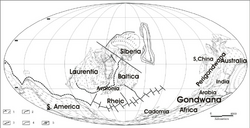Earth:Telychian
| Telychian | |
|---|---|
| 438.5 ± 1.1 – 433.4 ± 0.8 Ma | |
 Paleogeography of the Telychian, 435 Ma | |
| Chronology | |
| Etymology | |
| Name formality | Formal |
| Usage information | |
| Celestial body | Earth |
| Regional usage | Global (ICS) |
| Time scale(s) used | ICS Time Scale |
| Definition | |
| Chronological unit | Age |
| Stratigraphic unit | Stage |
| Time span formality | Formal |
| Lower boundary definition | Just above LAD of the brachiopod Eocoelia intermedia, below FAD of lowest succeeding species Eocoelia curtisi |
| Lower boundary GSSP | Cefn-cerig Road Section, Llandovery, Wales, United Kingdom [ ⚑ ] 51°58′12″N 3°47′24″W / 51.9700°N 3.7900°W |
| GSSP ratified | 1984[4] |
| Upper boundary definition | Imprecise. Currently placed between acritarch biozone 5 and LAD of Pterospathodus amorphognathoides. See Llandovery for more info. |
| Upper boundary definition candidates | A conodont boundary (Ireviken datum 2) which is close to the murchisoni graptolite biozone. |
| Upper boundary GSSP candidate section(s) | None |
| Upper boundary GSSP | Hughley Brook, Apedale, UK [ ⚑ ] 52°34′52″N 2°38′20″W / 52.5811°N 2.6389°W |
| GSSP ratified | 1980[5] |
In the geologic timescale, the Telychian is the third and final age of the Llandovery Epoch of the Silurian Period of the Paleozoic Era of the Phanerozoic Eon. The Telychian Age was between 438.5 ± 1.2 million years ago (Ma) and 433.4 ± 0.8 Ma. The Telychian Age succeeds the Aeronian Age and precedes the Sheinwoodian Age.[6] The name of the interval is derived from the Pen-lan-Telych Farm near Llandovery, Powys, Wales. The GSSP is located within the Wormwood Formation.
It ended with the Ireviken event.
Ireviken event
The Ireviken event was the first of three relatively minor extinction events (the Ireviken, Mulde, and Lau events) during the Silurian Period. It occurred at the Llandovery/Wenlock boundary (mid Silurian, 433.4 ± 2.3 million years ago). The event is best recorded at Ireviken, Gotland, where over 50% of trilobite species became extinct; 80% of the global conodont species also become extinct in this interval.
Anatomy of the event
The event lasted around 200,000 years, spanning the base of the Wenlock Epoch.[2][7]
It comprises eight extinction "datum points"—the first four being regularly spaced, every 30,797 years, and linked to the Milankovic obliquity cycle.[7] The fifth and sixth probably reflect maxima in the precessional cycles, with periods of around 16.5 and 19 ka.[7] The final two data are much further spaced, so harder to link with Milankovic changes.[7]
Effects
The mechanism responsible for the event originated in the deep oceans, and made its way into the shallower shelf seas. Correspondingly, shallow-water reefs were barely affected, while pelagic and hemipelagic organisms such as the graptolites, conodonts and trilobites were hit hardest.[2]
Geochemistry
Subsequent to the first extinctions, excursions in the δ13C and δ18O records are observed; δ13C rises from +1.4‰ to +4.5‰, while δ18O increases from −5.6‰ to −5.0‰.[2]
References
- ↑ Jeppsson, L.; Calner, M. (2007). "The Silurian Mulde Event and a scenario for secundo—secundo events". Earth and Environmental Science Transactions of the Royal Society of Edinburgh 93 (02): 135–154. doi:10.1017/S0263593300000377.
- ↑ 2.0 2.1 2.2 2.3 Munnecke, A.; Samtleben, C.; Bickert, T. (2003). "The Ireviken Event in the lower Silurian of Gotland, Sweden-relation to similar Palaeozoic and Proterozoic events". Palaeogeography, Palaeoclimatology, Palaeoecology 195 (1): 99–124. doi:10.1016/S0031-0182(03)00304-3.
- ↑ "Chart/Time Scale". International Commission on Stratigraphy. http://www.stratigraphy.org/index.php/ics-chart-timescale.
- ↑ Holland, C. (June 1985). "Series and Stages of the Silurian System". Episodes 8 (2): 101–103. doi:10.18814/epiiugs/1985/v8i2/005. http://www.episodes.org/journal/view.html?volume=8&number=2&spage=101&vmd=A#1. Retrieved 15 December 2020.
- ↑ "GSSP for the Rhuddanian Stage". http://www.stratigraphy.org/GSSP/Rhuddanian.html.
- ↑ Gradstein, Felix M.; Ogg, James G.; Smith, Alan G. (2004). A Geologic Time Scale 2004. ISBN 9780521786737.
- ↑ 7.0 7.1 7.2 7.3 Jeppsson, L (1997). "The anatomy of the Mid-Early Silurian Ireviken Event and a scenario for P-S events". Paleontological Events: Stratigraphic, Ecological, and Evolutionary Implications. New York: Columbia University Press. pp. 451–492.
 |

